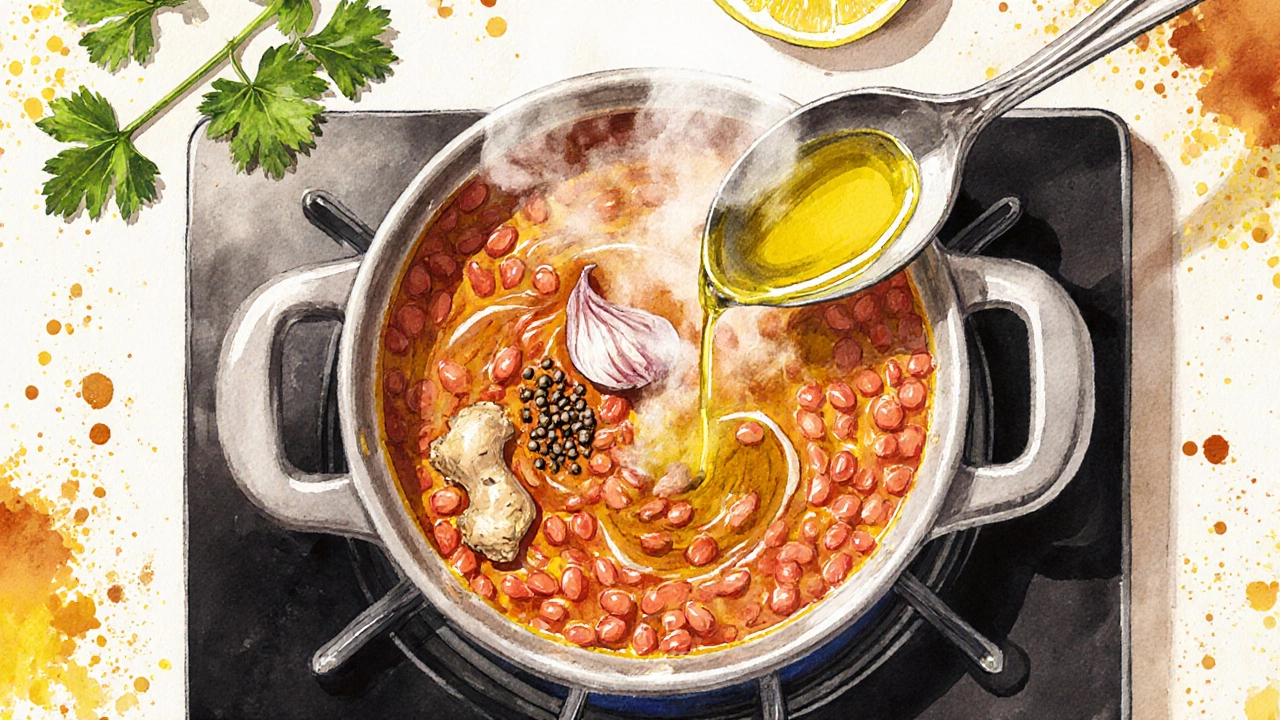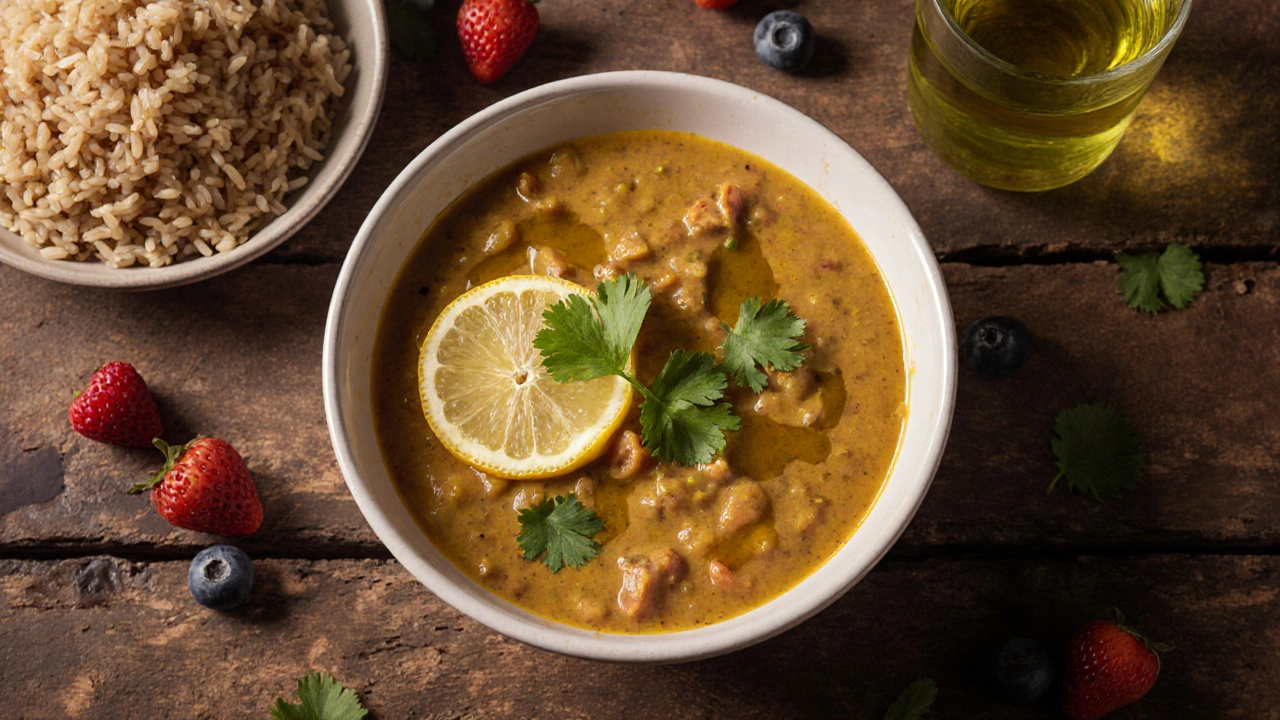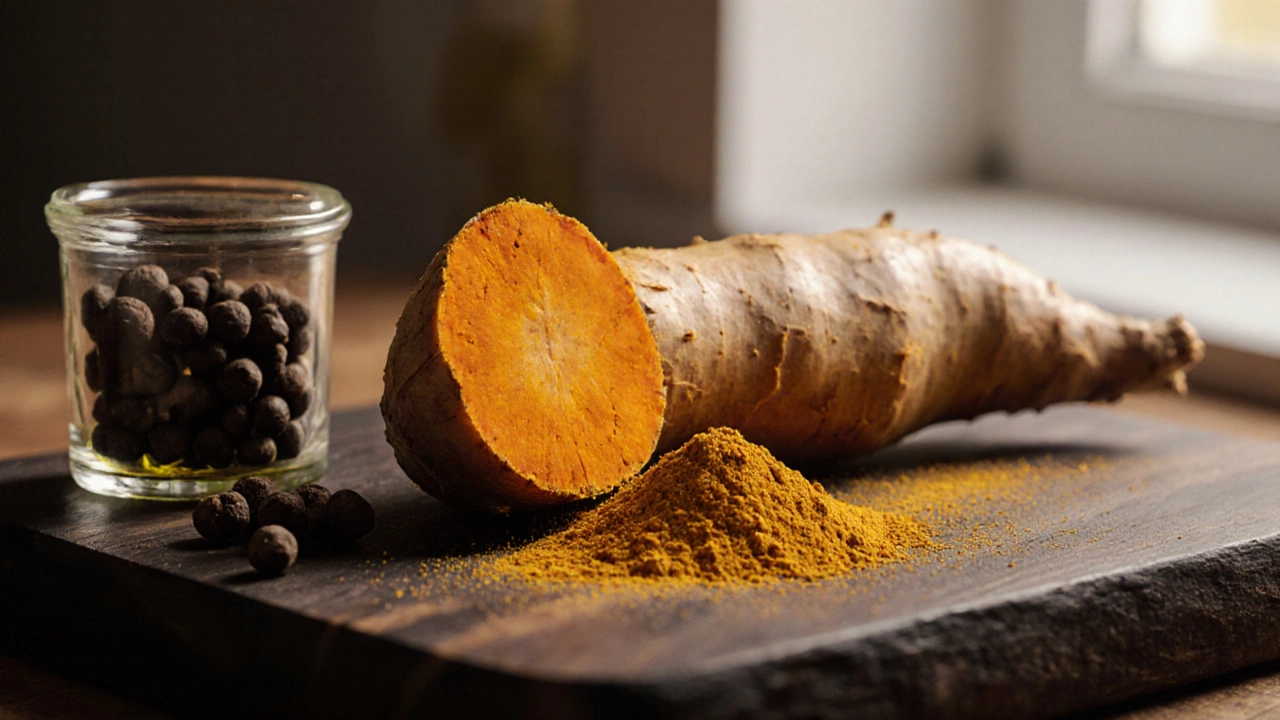Anti-Inflammatory Food Score Calculator
Find out how much your diet contributes to fighting inflammation. Select the anti-inflammatory foods you eat daily and see your total score.
Your Daily Anti-Inflammatory Foods
Select the foods you consume daily and adjust portion sizes to calculate your score.
Your Score
Perfect Score (10.0):
Eating all top anti-inflammatory foods daily
(Turmeric + Lentils + Ginger + Olive Oil + Green Tea + Berries)
Score range: 0-10.0 (Higher = greater anti-inflammatory effect)
Did you know that a single spice can cut inflammation in half? Researchers have measured a dramatic drop in inflammatory markers after people added just one ingredient to their meals. That ingredient is turmeric, a bright yellow rhizome native to South Asia, famous for its active compound curcumin. Below we’ll break down why turmeric tops the anti‑inflammatory list, how everyday staples like lentils reinforce the effect, and give you a simple dal recipe that turns a regular dinner into a healing bowl.
Why Inflammation Needs a Food Fix
Low‑grade, chronic inflammation fuels everything from joint pain to heart disease. It’s the silent driver behind insulin resistance, skin disorders, and even mood swings. While doctors can prescribe medication, diet offers a gentler, sustainable route. Food‑derived compounds can modulate the NF‑κB pathway, lower C‑reactive protein (CRP), and balance gut microbes-all without the side effects of steroids.
The Science Behind Turmeric’s Power
Turmeric’s superhero is curcumin, a polyphenol that blocks inflammatory enzymes like COX‑2 and reduces oxidative stress. In a 2023 double‑blind trial, participants who took 500 mg of curcumin daily saw a 30 % reduction in CRP after eight weeks. The compound also boosts the activity of antioxidant enzymes such as superoxide dismutase (SOD).
To unlock curcumin’s full potential, pair turmeric with a pinch of black pepper (piperine) and a healthy fat. Piperine can increase curcumin absorption by up to 2,000 %.
Lentils: A Plant‑Based Anti‑Inflammatory Ally
While turmeric steals the spotlight, lentils, small legumes packed with protein, fiber, and phytonutrients act as a steady anti‑inflammatory base. A study from the University of Copenhagen (2022) linked a diet rich in lentils to a 15 % drop in IL‑6 levels, a cytokine linked to chronic inflammation.
Lentils supply polyphenols, saponins, and resistant starch, which feed beneficial gut bacteria. A balanced gut microbiome produces short‑chain fatty acids (SCFAs) that calm the immune system.

Other Top Anti‑Inflammatory Foods
- ginger, a rhizome containing gingerol that inhibits prostaglandin synthesis
- garlic, rich in allicin, which reduces TNF‑α levels
- olive oil, extra‑virgin variety provides oleocanthal, a natural ibuprofen‑like compound
- green tea, contains EGCG, a catechin that blocks NF‑κB activation
- berries, blueberries, strawberries, and raspberries are loaded with anthocyanins that lower oxidative stress
Simple Anti‑Inflammatory Dal Recipe
This dal combines lentils with turmeric, ginger, garlic, and a splash of olive oil to create a potent anti‑inflammatory bowl. The recipe takes under 30 minutes and serves four.
- Rinse 1 cup of red lentils until water runs clear.
- In a pot, heat 2 tablespoons of olive oil over medium heat.
- Add 1 teaspoon of minced garlic and 1 teaspoon of grated ginger. Sauté 30 seconds.
- Stir in 1 teaspoon of turmeric and a pinch of black pepper.
- Add the lentils, 3 cups of water, and ½ teaspoon of salt. Bring to a boil, then reduce to a simmer.
- Cook until lentils are soft (about 15 minutes). If you prefer a smoother texture, blend half of the dal with a hand blender.
- Finish with a squeeze of fresh lemon juice and a garnish of chopped cilantro.
Serve with brown rice or whole‑grain roti for a complete, gut‑friendly meal.
Tips to Maximize Anti‑Inflammatory Benefits
- Combine fats and spices: Curcumin and gingerol are fat‑soluble. Cooking them in olive oil or ghee boosts absorption.
- Use fresh ingredients: Fresh turmeric and ginger contain higher levels of active compounds than dried powders.
- Mind the temperature: Over‑heating can degrade delicate antioxidants like EGCG in green tea. Keep tea steeping below 80 °C.
- Balance with fiber: Pair anti‑inflammatory foods with high‑fiber sides to support gut health, which in turn dampens systemic inflammation.

Common Mistakes to Avoid
Many people think adding a pinch of turmeric is enough, but without black pepper or fat the body absorbs only a fraction of curcumin. Similarly, using canned lentils that are rinsed in salty brine can re‑introduce sodium‑induced inflammation. Always opt for dry lentils or low‑sodium canned versions.
Quick Reference: Anti‑Inflammatory Food Comparison
| Food | Key Compound | Anti‑inflammatory Score* | Additional Benefits |
|---|---|---|---|
| Turmeric | Curcumin | 9.5 | Supports liver detox, joint health |
| Lentils | Phytonutrients & Resistant starch | 8.2 | High protein, stabilizes blood sugar |
| Ginger | Gingerol | 8.0 | Relieves nausea, improves digestion |
| Olive Oil | Oleocanthal | 7.8 | Heart‑healthy monounsaturated fats |
| Green Tea | EGCG | 7.5 | Boosts metabolism, supports brain health |
*Score based on peer‑reviewed studies rating reduction in CRP and cytokine levels (scale 1‑10).
Frequently Asked Questions
Can I take turmeric supplements instead of using the spice?
Supplements provide a concentrated dose of curcumin, but many lack piperine, which means absorption stays low. If you choose a supplement, look for a formula that includes black pepper extract or a liposomal delivery system.
How often should I eat anti‑inflammatory foods?
Aim for daily inclusion. A serving of turmeric (½ tsp), a cup of lentils, and a handful of berries each day keeps inflammatory markers in check for most people.
Is there a risk of over‑consuming turmeric?
Very high doses can irritate the stomach or interfere with blood thinners. Sticking to culinary amounts (up to 2 tsp per day) is safe for most adults.
Can I use other legumes instead of lentils?
Yes-chickpeas, black beans, and split peas also contain anti‑inflammatory polyphenols. Adjust cooking times accordingly.
What’s the best way to store fresh turmeric?
Wrap it in a paper towel, place in a sealed bag, and keep it in the refrigerator’s crisper. It stays fresh for up to three weeks.
By building the anti‑inflammatory food into everyday meals-starting with turmeric, lentils, and a few supporting ingredients-you can lower chronic inflammation without prescription drugs. Try the dal tonight, and feel the difference in your joints, energy, and mood.
